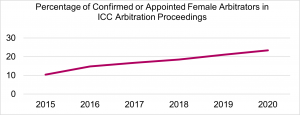
Arbitration and ADR
Guest blog: Gender diversity in arbitral tribunals – The challenges ahead
Diversity is a complex and intersectional issue, and while incremental progress has been made, much remains to be done. With next week’s ICC Miami Conference on International Arbitration just around the corner, Christian Albanesi, Mateo Noseda Zorrilla de San Martín, Charlene Warner and Somin Lee of Linklaters take the opportunity to reflect upon the progress achieved so far and the challenges still to come.
The Equal Representation in Arbitration Pledge (ERA Pledge) was launched in May 2016. Since its introduction, the ERA Pledge has garnered over 4,000 signatories from law firms, institutions, organisations, and individuals in over 113 countries committed to increasing the number of women arbitrators.
Why gender diversity matters in arbitration
Gender diversity in international arbitration leads to a better arbitral process and outcome. As A.F. Haridi put it, sufficient diversity on the arbitral tribunal is “crucial to sustaining arbitration as a modern, feasible and desirable method of dispute resolution” so that arbitration users “view the tribunal as representing a cross-section of the business world.” Studies show that diversity brings in diverse perspectives which allow the quality of group reasoning and decision making to improve. A survey published in 2016 found that “[a] diverse tribunal may be better prepared, more task-oriented, and more attentive to parties’ arguments than a non-diverse tribunal.
ICC statistics
ICC has been leading the way for aspirational diversity in arbitration by publishing diversity-related statistics, setting the tone from the top and appointing more women arbitrators. In 2020, ICC made 1,520 appointments and confirmations. With 355 women arbitrators confirmed or appointed by the ICC Court, the percentage of women sitting in ICC arbitral tribunals reached 23.4% in 2020, a record for the arbitral institution. Last year also saw female appointees make up 37% of the ICC Court’s total arbitrator appointments, 28% of co-arbitrator chair appointments and 16% of party appointments, all figures seeing an increase compared to 2019.
A steady increase in the percentage of female arbitrator confirmations or appointments can be seen at ICC since the introduction of the ERA Pledge in 2015, where ICC saw 10.4% of female appointments or confirmations.
Issues that still need to be addressed
Certain challenges to the ERA Pledge’s goal of equal representation remain, including:
- Practice to select male arbitrators with more experience, who often are more well-known;
- Diversity is not always a priority or criterion in the arbitrator appointment process among stakeholders;
- Difficulty of first appointments or relatively newer arbitrators who are women;
- Lack of retention and promotion of women in the legal profession, who otherwise may eventually have become experienced arbitrator candidates; and
- Unconscious and implicit gender bias among the legal profession, and society in general.
The way forward for equal representation in arbitration
As the greater arbitration community works to move the needle in the right direction, much more needs to be done to achieve full gender parity for women. To do so, various stakeholders have a lasting role to play.
While the statistics around the world show improvement in institutional appointments, party appointments are still trailing. Institutions are possibly the loudest advocates of diversity in arbitration, and perhaps, one of the most effective players. Institutions should continue to promote the profiles of newly minted female arbitrators in the arbitration community.
Law firms should increase the visibility of their female lawyers by investing in training and putting female lawyers in front of their clients, conferences and panels. Law firms should also improve the retention and promotion of female talent. Having women in senior leadership roles within law firms ultimately helps build confidence in women decision-makers and arbitrators while combatting unconscious bias.
Party appointment is one of the largest hurdles to increasing the number of female arbitrators. As one of the key stakeholders, corporate users can make a commitment to specifically request the inclusion of female candidates in shortlists of potential arbitrators. This commitment can manifest itself in setting internal processes for selecting arbitrators such as requiring gender and other diversity factors (such as race) as part of the process and following other recommendations set forth in the ERA Pledge Corporate Guidelines.
While many corporate users have shared their aims to diversify their arbitrators and legal teams, the statistics and actual initiatives have not been as transparent. Not all of the signatories to the Pledge have publicised what actions they are taking to implement concrete measures, and of those who have written on the subject, few have specifically detailed plans of action.
There is a big role for men to play, especially because men comprise the largest proportion of senior stakeholders in the legal profession. Increasingly more men are serving as allies to women and continuing to promote visibility for women practitioners, encouraging clients to think outside the box and put forth an equal number of qualified women and men in proposed arbitrator candidate lists.
Let this be an opportunity for all of us to renew our commitment towards multiplying diversity in international arbitration.
Linklaters is a sponsor of the ICC Miami Conference on International Arbitration, which is set to take place from 12-14 December.
*Disclaimer: The content of this interview does not reflect the official views of the International Chamber of Commerce. The opinions expressed are solely those of the authors and other contributors.

